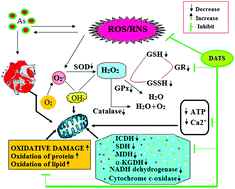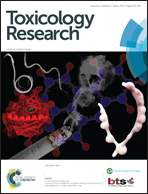Cardiac mitochondrial oxidative stress and dysfunction induced by arsenic and its amelioration by diallyl trisulphide
Abstract
Mitochondria are the particular target of arsenic (As) in the cell. Cell death induced by As is associated with mitochondrial membrane depolarization and release of cytochrome c from the mitochondria. DATS is a lipophilic organosulfur compound found in garlic, which is known for its potent biological and pharmacological effects. Hence, this study was aimed to investigate the protective role of diallyl trisulphide against As induced oxidative stress in cardiac mitochondria. Mitochondria were isolated from the heart tissue of rats from all the groups and used for this present study. The exposed rats showed significant increases in lipid peroxidation products, mitochondrial swelling, NO concentration, H2O2 production, the concentration of arsenic in cardiac tissue and mitochondria, and alterations in the lipid profile of mitochondria. Significant decreases in mitochondrial antioxidant and Krebs cycle enzymes, cytochrome-c-oxidase, ATP, Ca2+ level, oxygen consumption rate and mitochondrial membrane potential were observed in the heart mitochondria of As exposed rats. All these changes caused by As could be lessened by the pre-supplementation of diallyl trisulphide. The protective effect of DATS on the heart mitochondria was evidenced by altering all the changes induced by As and it is supported by TEM results. All these activities of DATS may be responsible for the defensive action of DATS against As induced mitochondrial damage in the heart.


 Please wait while we load your content...
Please wait while we load your content...